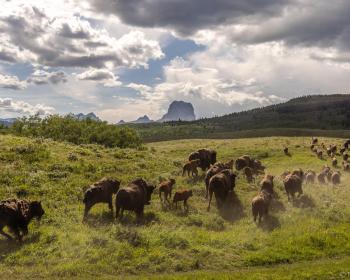One hundred and forty-one people, led by Native Hawaiians, were arrested on 25 March 1990 as part of the largest demonstration yet against geothermal development in Hawaii. The gathering was intended to focus attention on Native Hawaiian rights and the ecological consequences of drilling geothermal wells in the near-pristine Wao Kele O Puna rain forest. The energy project, undertaken by True Geothermal Company and endorsed by Hawaii's governor and other imposing figures, has already invaded the largest intact tropical lowland rain forest in the United States.
More than 1,500 protesters showed up for the demonstration on the "Big Island" of Hawaii to express their solidarity and outrage over rainforest destruction and the denial of Native Hawaiian rights. Representatives from more than 30 groups concerned with social and environmental issues participated, including the demonstration's co-sponsors, the Pele Defense Fund and the Big Island Rainforest Action Group.
Native Hawaiians led the crowd in a silent walk up the newly razed road to the gate intended top seal off Wao Kele O Puna (meaning "the rain-belt of Puna"). The peaceful protest was staged in front of a 12-foot-high cyclone fence topped with three double strands of barbed wire. The fence, dubbed "True's Berlin Wall," had been constructed in front of the drilling site just two days before the action. Those arrested - on charges of trespassing or obstructing police - intended to show their force against the unjust development. In honor of those arrested, the remaining protesters tied green ribbons and Hawaiian Ti leaves on the fence.
Land Swap or Land Grab?
The Wao Kele O Puna Natural Area Forest Reserve is part of the 1.5 million acres of Crown and Hawaiian Kingdom lands that were first confiscated from Native Hawaiians and then ceded to the US government in 1898. Once Hawaii became a state, the lands became part of the ceded public lands trust, managed by Hawaii's Department of Land and Natural Resources on behalf of Native Hawaiians and the general public.
Prior to being opened up for energy development, the Wao Kele O Puna rain forest was a natural reserve set aside to protect native plants and animals. As part of the ceded public lands trust it was legally dedicated to the use of the Hawaiian people in "perpetuity". In 1985 this land was approved for development through a state-organized land swap with the powerful Campbell Estate. More than 27,000 acres of "public trust" land in the Puna forest reserve were traded by the Department of Land and Natural Resources for 25,000 acres of adjacent private land at Kahaualéa.
The Kahaualéa land was originally slated for geothermal development until it was partially covered by a fresh lava flow. Fifteen thousand acres of Kahaualéa are now covered with lava, and 1,200 acres have promised to the adjoining Volcano National Park. This leaves the public land trust with only 3,200 acres of forested land.
Because the state eliminated contested case hearings, citizens were denied their rights. Native Hawaiians in coordination with the Pele Defense Fund are challenging the land swap in court, but in the meantime destruction continues daily. The Pele Defense Fund argues that the state illegally streamlined the geothermal permit process to discourage public debate. The suit also accuses the Department of Land and Natural Resources of breach of trust in not looking out for the interests of Native Hawaiians.
The Big Island police chief, Victor Vierra, wants each of the arrested protesters to be find $400 (in addition to the other fines) in order to cover police and National guard expenses for "keeping peace" at the protest. Vierra claims that the protest cost the state and country more than $55,450. But the three dozen armed police - some flown in from the neighboring island of Oahu - were largely unnecessary, since from the outset the demonstration was intended to be nonviolent.
Part of a Birthright
Those who support the lawsuit do not recognize Campbell Estate as holding ownership of the Wao Kele O Puna rain forest. They maintain that Native Hawaiians have the right to hunt and gather on the land, since access to the forest is part of their birthright.
Pele, the volcano goddess of the Hawaiian people is manifested in Kilauea and surrounding areas. The Hawaiians of the Puna district trace their ancestry to Pele and her family who dwells on the land. Native Hawaiians who believe in Pele understand that geothermal development will injure her and that she will retaliate. Removing geothermal steam, they argue, will suck the life force out of Pele.
Native Hawaiians are fighting destruction of the Wao Kele O Puna rain forest on religious grounds: development, they maintain, will damage the salient image of Pele. Hawaiians argue that the Wao Kele O Puna rain forest was so sacred to their ancestors that if a large tree from it were to be cut, a human life had to be sacrificed. Thus, they assert, shows the sacred potency that Hawaiians have long attributed to the area.
Destroying the rain forest will also deny the rights of Hawaiians who gather medicinal plants. The rain forest has supplied traditional healers with necessary plants since long before the arrival of Europeans. Native Hawaiians are now being humiliated; they are expected to defend their religious beliefs to an insensitive government. For them, Wao Kele O Puna is sacred ground.
The Costs of Geothermal Power
The environmental consequences of the project are also significant. The geothermal project is planned as the biggest energy project undertaken in Hawaii. Some 95 percent of the plant and animal species found in the area exist nowhere else in the world. And the hazards of drilling geothermal wells and operating power plants in one of the world's most geologically unstable areas cannot be dismissed.
Geothermal wells produce hydrogen sulfide, a toxic gas that, when mixed with air, becomes sulfuric acid (one of the main components of acid rain). Typical of Hawaii's lax environmental policies, the state has no air quality standards for hydrogen sulfide. The levels of hydrogen sulfide that will be emitted by the wells can cause, among other things, headaches, lung irritations, nausea, and vomiting. The toxic gases emitted by a single geothermal well drilled nearby in the early 1980s become so bad that at one point the operation had be shut down and residents evacuated.
Biologists fear that the toxic emissions will drive off birds and insects that pollinate the great Ohiá trees - pollination, one substantial earth movement - a commonplace occurrence in this sensitive area - could destroy wells and pipelines, thereby dispersing toxins into the air and soil. Noise pollution, too, will affect resident and wildlife. Because of the enormous pressure created by the surfacing of underground gases, the geothermal wells need periodic venting, a process with a decibel level of a 747 taking off that can last for hours on end.
To produce the intended 500 megawatts of electricity, at least 140 geothermal wells will have to be drilled. These wells will produce vast quantities of toxic brine containing arsenic, lead, mercury, manganese, and cadmium along with other heavy metals and toxic chemicals. By using settling ponds to deal with this brine, soil and groundwater contamination would be difficult to avoid and hard to detect. Because of the unique lava tube ecosystems of the region, the reinjection of brine may not be possible (lava tubes are underground corridors formed by lava flowing through the area). These ecosystems are habitats to rate fauna, including rare spiders. Injecting toxic brine could destroy these largely unexplored tubes.
While only about one percent (300 acres) of the rain forest will be directly destroyed by bulldozing, the rest will be fragmented by a network of roads, pipes, and power lines. The acreage to be razed is not contained within one 300-acre parcel, but will be scattered around the forest in smaller clearings. Fragmentation of this type makes the forest vulnerable to invasion of harmful non-native species, and slices away at the very integrity of the land. To the disgrace of development, Hawaii contains more than half of the total number of endangered plants and animals in the United States. It is absurd to destroy or heavily impact the largest remaining rain forest refuge in the state.
And what would the 500 megawatts of power be used for? More overdevelopment in Hawaii, of course. The power plant would produce more than three times as much electricity as the Big Island currently uses, and any excess power be transmitted to neighboring islands via an underwater cable. Overland, across the islands of Maui and Oahu, ninestory-high power lines would carry electricity from the big Island. On Maui alone the high-tension lines would stretch across an area that contains more than 350 irreplaceable archaeological sites.
A "Renewable" Energy Source?
The geothermal project is absolutely unnecessary. The amount of money already spent on research alone for the underwater cable could have been used to install solar panels for every residence on Oahu, Hawaii's most populated island. Solar and wind power, along with implementation of conservation measures, show that geothermal development is a poor alternative to sane energy use. All of Hawaii's energy demands can be met through efficient and clean alternatives.
Geothermal has been called a "renewable' energy source; it is more renewable, however, than oil or coal. It is widely agreed that the life of a geothermal well is only 20 to 30 years. And geothermal development will not reduce Hawaii's dependency on imported oil, as is claimed by proponents. Sixty-six percent of the oil imported into Hawaii is used for transportation. The oil used to generate electricity is residual oil - the stuff left over after refining crude for transportation fuel. Therefore, the limited factor in Hawaii's oil consumption is transportation, not electricity. In fact, Hawaii produces more residual oil than it uses, and there are no plans to close any fossil fuel plants.
In 1989 True Geothermal company bulldozed twice the area "approved" for development, receiving only a token fine. But perhaps the greatest irony was felt when prodevelopment factions called antigeothermal activists "wealthy outsiders" (True Geothermal, incidentally, is based in Wyoming) - the March protest, after all was led by Native Hawaiians. But this fight transcends racial and geographical boundaries - it truly is a global issue. If the United States cannot protect its own rain forests, how for example, can we expect other countries to listen to our pleas to protect their own?
Peacefully, and with continued civil disobedience, Native Hawaiians vow to fight this battle to the end. Too much, they maintain, is at stake, and nothing is to be gained. The Hawaiian poet looks to the land at Puna and chants to pleas:
Puna is dancing in the wind
The pandanus groves are dancing at Keáau
The land of Háena is dancing with Hopoe
The women dances
Moving her hips in the sea on Nanahuki
A hula that is all delight
In the sea of Nanahuki.
How You Can Help
Immediate action is essential. Write Hawaii's governor and insist that he reconsider his position on geothermal development. Let him know that the rest of the country is watching. Ask him to pursue environmentally sound alternatives and to respect the rights of his own people. His address is:
Governor John Waihee
State Capitol
Honolulu, HI 96813
For more information about the Pele Defense Fund, including its 30-minute ethno-documentary video entitled "Pele's Appeal" ($35 per copy), write:
Pele Defense Fund
P.O. Box 404
Volcano, HI 96785
Article copyright Cultural Survival, Inc.


